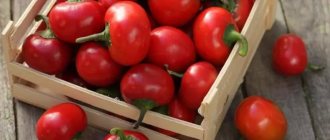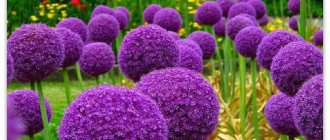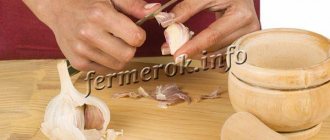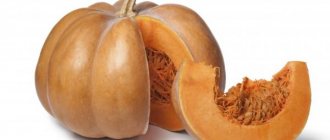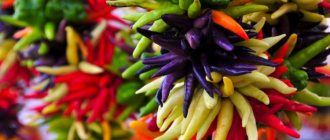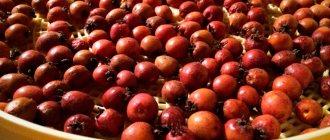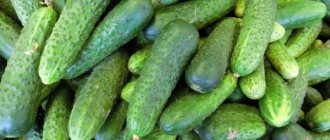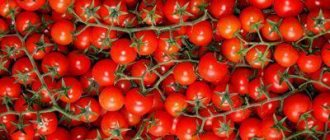Description of white onion
The shape of this variety resembles yellow. Its color is white, slightly transparent. The heads are round in shape, elongated ones are rare. The taste is delicate, practically without bitterness; onions do not add harshness to dishes. This feature makes it popular among gourmets; it is grown especially for salads.
In Russia, white onions are little known, but in some countries they are very popular. These countries include Asian countries, as well as Mexico and Spain. In France, the legendary onion soup is made from this species.
Unfortunately, white onions do not have a long shelf life. After being collected from the garden, it begins to deteriorate after a couple of months. Therefore, you need to use it for food as quickly as possible. And it’s better to eat salads with it in one sitting, without leaving it for tomorrow - due to the loss of valuable nutrients.
Features of agricultural technology
Onions are grown in the garden in two seasons:
- sowing nigella to obtain seedlings - this is the first year;
- planting sets to obtain a full-fledged turnip is the second year.
If you have purchased sets, then already in the first year you can get high-quality white onions.
In the southern regions, when sowing with seeds, you can get a turnip in the first year.
Selecting a location
The best place for onions is a sunny, wind-protected bed where legumes, cucumbers or tomatoes grew in the previous season.
ON A NOTE!
Return onions to the garden no earlier than after 3-4 years, observing the rules of crop rotation.
The soil should be loose and neutral in acidity. White onions do not like acidic soils, so ash or dolomite flour is added to such soils. In the fall, carefully dig up the bed, add a small amount of rotted compost, as well as superphosphate (about 25-30 grams per square meter).
Seed preparation and sowing
Sowing of seeds is carried out either directly on the ridges, or by first growing seedlings at home. Most gardeners prefer not to bother with onion seedlings, since in the spring there is too much trouble with seedlings of other vegetables. Therefore, seeds are sown, having previously prepared them, directly into the ground.
- Nigella is disinfected in a solution of potassium permanganate (up to six hours).
- Soak in any growth stimulator (according to instructions).
- The seeds are germinated in a damp cloth, then slightly dried and sown immediately on the prepared bed.
The sowing time depends on the region: in the middle zone you can sow as early as April, but for Siberia, the Urals and the North-West regions later, already in May.
It is best to sow nigella in cut grooves, keeping a distance between them of 15-20 cm. The seed sowing depth is up to 3 cm. Then sprinkle the nigella with soil and water it.
After the first shoots appear, it is advisable to do the first thinning. It will be necessary to thin out the second time later, when the plants reach about 10-12 cm.
Planting sets
Just like when sowing nigella, the seed must be prepared before planting. To begin with, sorting is carried out, removing all damaged, low-quality specimens, then the sets are heated at a temperature of +30°C, 8-10 hours will be enough.
Then carefully cut off the top part of the onions, soak the sets in a special solution that speeds up germination (ZIRCON is perfect).
The seedlings are sown on the prepared bed only when the soil warms up to +10-12°C, planting the onions in the grooves in the same way.
Scheme: the distance between the bulbs is 8-10 cm, between the grooves – 20 cm.
If everything is done correctly, then in about a week the white onion will sprout.
You may be interested in: Dates for planting leeks for seedlings in 2021 throughout Russia Dates for planting onion sets in 2021 for feathers and turnips in different regions of Russia Harvesting onions according to the lunar calendar 2021 in Siberia
Onion feeding
Onions, like other vegetables, need feeding. But you need to know that if the bed has been well fertilized since the fall, then there is no need to apply a lot of fertilizers during the growing season.
It is effective to use complex fertilizers for fertilizing; you can also use organic matter in the first period.
ON A NOTE!
Onions do not like fresh manure, so it cannot be added to the beds either in the fall, or even more so in the spring.
The condition of the plants is an excellent indicator of whether the onion needs any feeding or additional substances or not. Excess nitrogen leads to the growth of green mass, not bulbs, so in the second half of the growing season, fertilizing with potassium and phosphorus should be predominant.
You also need to roughly calculate when to remove the onions from the garden, so that all fertilizing and watering are stopped two to three weeks before.
Watering
Do I need to water onions? Yes, especially if the weather is hot and dry and there is no precipitation. But you should not allow an excess of moisture in the garden so that the water stagnates. This leads to rotting of both the turnip and the feather, and the appearance of various vegetable diseases.
Usually, plants are watered more often in the first months after planting, gradually reducing the amount of watering and water, and stopping them completely two to three weeks before harvesting.
This will enable the turnip to gain maximum weight, ripen better, and accumulate more nutrients.
Known varieties
When choosing varieties of white onions to plant in their gardens, gardeners strive to purchase ones that have a long shelf life and have excellent taste. The most popular varieties:
- Comet. An amazingly sweet variety that can be stored for up to 6 months. Disadvantages include the small size of the bulbs and a long ripening period (up to 120 days).
- Alba. The bulbs are large, on average 80 g, but can grow up to 200 g with good care. Grown for up to 120 days, stored for 6 months.
- Nevada. Early ripening variety. The bulbs are medium in size and ripen in 90 days. The variety is suitable for regions with short summers.
- Snowball. These bulbs have the largest size - up to 160 g. They ripen in 105 days. However, they are stored for no more than 3 months.
- Sterling. A variety with a short shelf life, no more than 4 months. The bulbs reach 120 g and have an excellent sweet taste. The variety is resistant to onion diseases.
These are the main names of white onions grown in garden beds. Based on these characteristics, you can choose a variety that best meets the requirements of any gardener.
Snowball
Do you want to be modern and follow the latest trends in onion growing? Then choose the Snowball variety. Today, many gardeners can boast of an excellent harvest of this onion. A distinctive feature of this variety is that the outer scales of this round white onion are even more juicy than the inner ones. The variety is a mid-early variety, which means a good harvest will not take long to arrive. Well, those who have already managed to grow more than one Snowball crop on their plot also praise it for its good keeping quality and resistance to bolting.
| Use | Taste | Growing method | Bulb weight (g) | Keeping quality | |
| semi-sharp | 120-200 | average | |||
Valuable qualities and consumption
White onions contain many vitamins and beneficial elements. It contains a lot of B vitamins, there are also vitamins C, E, H, PP.
The vegetable contains a large amount of minerals necessary for humans - manganese, magnesium, potassium, phosphorus.
Experts recommend consuming fresh onions in salads. During long-term storage and heat treatment, all valuable components are destroyed.
Doctors advise people suffering from high sugar levels in the body to use white onions as food. After all, one of the main components of the vegetable is the component glucinin, which reduces the amount of sugar. Regular consumption of onions helps activate the formation of red blood cells. For this reason, people with anemia are advised to consume onions. In addition, the vegetable promotes the production of gastric juice, thereby increasing appetite. A plate of salad dressed with onions for lunch or dinner will significantly improve anyone's appetite.
In addition to these valuable properties, white onions normalize lymph flow, eliminate cholesterol and increase the impermeability of vascular walls. The beneficial effect of using white onions can be achieved by adding even a small amount to your food.
White onions, a photo of which is presented in the article, will help diversify:
- salads;
- soups;
- second courses;
- sauces.
White onions, unlike regular onions, when added to a salad will not add bitterness to the taste, so they are preferred by those who do not like sharp sensations. Dishes with such onions become real culinary masterpieces.
Traditional French onion soup is made from this vegetable. And who, if not the French, knows a lot about delicious recipes!
Alba
Alba is Latin for “white.” The scales remain snow-white, do not darken and are not torn off for up to six months, so the variety is excellently stored, which not every white onion can boast of. To reach maturity, Alba needs a long growing season - about 130 days. The bulbs are not very large, but at the same time dense, juicy, with crispy flesh.
Related article:
Onions and garlic: Everything gardeners need to know
The taste is characterized as medium-sharp, but when peeled, phytoncides do not have such a dramatic effect on the mucous membranes of the eyes as with yellow or red onions.
Is there any danger?
In addition to the benefits, there are also harmful aspects. For example, eating onions that have not been heat-treated can irritate the mucous membranes in the digestive system and increase stomach acidity.
Onion dishes can increase nervousness and blood pressure. Another disadvantage of onion consumption is bad breath. Allergic reactions are possible in children.
People suffering from migraines should use onions with caution. Also, it should not be abused by those who have serious problems with the heart, liver, kidneys and gastrointestinal tract. Eating foods with onions can cause increased gas formation.
Planting and care
White onion varieties are grown for two years. In the first year, seeds are sown in the beds and onion sets are obtained in the fall. The next year it is planted and by autumn you get full-fledged bulbs.
It is better to plant onions in beds where beans, beans, as well as cucumbers and tomatoes previously grew. In autumn, ash and humus are added to the soil and dug up. At the end of April, the sets are planted at a distance of 10 cm from each other. Frosts down to -4°C are not harmful to sevka.
In the first weeks after planting, it is important to weed the beds from weeds so that they do not choke the young shoots.
Poor soils must be fed. Suitable:
- nitrophoska;
- superphosphate;
- urea.
When applying fertilizers, it is important not to exceed their concentration.
Water the beds twice a month, and once a week during dry periods.
Growing
Until recently, white onions were grown from sets; today, breeders have developed varieties that are intended for annual sowing, namely through seedlings.
Using seeds
It is important to choose the variety here. The bag of seeds must indicate “annual crop” or “planting through seedlings.” With this method, the main task is to obtain high-quality seedlings. To achieve it, you need to follow all the recommendations for sowing seeds for seedlings.
Landing dates
The timing directly depends on the growing conditions, the capabilities of the gardener and the varietal characteristics of the onion. Seeds need two months to fully develop into seedlings, so the sowing time is calculated. It is best to do this in the second ten days of February and extend until the end of the month. In this case, you can start planting in open ground in the second half of April.
The deadline can be extended until mid-March, in which case you may encounter onion fly, which peaks in May.
If you are late with the sowing time, the seedlings will turn out small and will hurt when transplanted, the same will happen if you sow too early. If you have a greenhouse, you can get strong planting material by placing containers with onions in it.
Site selection and preparation
A well-lit area of the garden is suitable for white onions. It is better to place the beds on the ground where melons or potatoes grew. The soil for onions should be loose and fertile. Sandy or loamy soils with a neutral reaction are suitable.
The bed for white onion seedlings needs to be prepared in the fall. To do this, the soil in the designated area is well dug up with phosphorus-potassium fertilizers applied. In spring, you don’t have to dig up the soil. Humus or ash is scattered on top of the bed and lightly mixed with the soil using a rake. Furrows are made throughout the ridge. Each hole should be well watered with settled water.
See also
Characteristics of Carmen onions, growing and caring for beds
Read
Planting scheme
Leave 30 cm between rows. This will make it easier to process the crops: loosening, weeding and watering. Between adjacent bulbs leave 5 to 10 cm. This indicator depends on the size of the onion.
Seedlings are planted in warm weather, preferably in the evening, when direct sunlight will not fall on the young onion. Before planting, seedlings are trimmed. If the roots are long, then they are shortened by half, the feather is trimmed, leaving two-thirds. There is no need to completely get rid of it, since it contains nutrients for the initial development of onions.
Sevok
Planting white onions through sets is a completely different agricultural technique. It is also important not to miss the correct planting dates, as well as to properly prepare the planting material.
Deadlines
In this way, a full-fledged head is obtained in the second year. In the first year, sets are grown. The optimal time for planting sets depends on the variety, each of which has its own ripening period.
It is best to plant from the end of March to the end of April, if possible, that is, the bed has been prepared in the fall, you do not have to wait for the garden to be plowed, and weather conditions allow planting.
Warming up
The seedlings selected for planting are warmed up. This is done at a temperature of +45 degrees for 7 hours. Warming up is used to prevent the bulb from releasing its arrow in the future.
Disinfection
Just before planting, it is soaked in a solution of 1% potassium permanganate to destroy pathogenic microbes. Potassium permanganate can be replaced with a solution of Fitosporin or regular baking soda. A water-salt composition is used against pests.
Stimulation of growth
The day before the main planting, the seedlings are placed in a plastic bag and lightly sprinkled with water. This technique will revive small onions that have been lying around for the winter. The roots will begin to swell at the bottom, which will then quickly begin to grow when they come into contact with the soil.
Harvest and storage
Is the pen starting to dry out? The onion is ripe! This usually happens at the end of July, and by the end of August - beginning of September, onions can be harvested.
If the leaves do not fall on their own, they are crushed by hand. You don't have to wait for it to dry completely. The feather will dry out during the drying process.
Onions are pulled out of the beds or dug up. It is stored in a cool place under a canopy for a week. It is important to dry the onions properly, this will ensure their long-term storage. White salad onions are not stored for long, but they can easily last until December if the necessary conditions are created.
If the harvest is large, this allows it to be used for home canning. The beautiful appearance of the bulbs makes them suitable as an addition to other vegetables, as well as for preparing canned winter salads.
How to properly harvest and store the crop?
It is best to remove ripe onions from the garden on a dry, sunny day. To work, you will need a shovel: you should not pull the bow by the feathers. It is recommended to lightly dig up the soil near the bulbs, then carefully pull them out, shaking off any remaining soil with your hands. If the neck of the vegetable is juicy, it means that it is not ripe; it is better not to store such bulbs, but to put them aside so that they can be immediately taken to the kitchen.
See also
When and how to harvest onions in the northwest: recommendations for digging in different regions of RussiaRead
After the onion is dug up, it needs to be laid out directly with the feathers for drying in the same bed on the ground or cardboard. It is advisable that the warm rays of the sun fall on it. In the evening, it is recommended to put them in a dry place or cover them with film so that the bulbs do not get wet from the morning dew. Dry depending on the weather - from 7-10 days.
If the onion becomes rustling, smooth and slippery, you can easily stick your hand into it - this means that it has already dried well. Now you need to use scissors to cut off the leaves on the bulbs, leaving about 5-6 cm of the neck. For storage, onions are best placed in a dry place at room temperature. You can place it in nets, wooden boxes, cardboard boxes, fabric bags or nylon stockings. You can not cut the leaves, but weave a braid in the form of a braid. Hang fagots in the kitchen. In this form, the vegetable is well preserved.
If you had to dig up a vegetable in rainy weather, then there is nothing left to do but process it correctly.
To do this you need:
- immediately cut off the feathers, retreating 5 cm from the neck;
- carefully remove the roots;
- clean the scales;
- Place one onion at a time in a dry place to dry for 2–3 weeks.
If the room was dry and well ventilated, then the onion can be preserved, and the husk will then grow again.
Medicinal prescriptions
Traditional medicine offers several useful recipes for using white onions:
- For dandruff. Onion juice is mixed with cognac in a ratio of 5:1, rubbed into the scalp an hour before washing, and washed with mild shampoo. The procedure can be performed twice a week.
- For furunculous acne and callous formations on the skin. The onion is baked, mixed with butter, the finished mixture is applied to the area of inflammation, secured with gauze.
- From burns. Cover the damaged area with onion pulp and fix it with gauze. The method is also good for frostbite.
- Against cough. Onion pulp is mixed with honey and stored in a cool place overnight. The resulting syrup is taken one tablespoon at a time.
- For otitis. The chopped onion is placed in gauze, kept over boiling water in a colander for 10 minutes, then applied to the ear, wrapped in a scarf and kept for up to one hour.
- For insect bites. Immediately after a bite, it is useful to wipe the skin with a white onion, this will help prevent swelling and inflammation.
- From deprivation. Onion rings are applied to the affected area, secured and held for two hours.
- For rheumatic pain. Onion juice is rubbed into sore joints and covered with a gauze compress.
These traditional medicine recipes are provided for informational purposes only. The use of any prescription requires mandatory consultation with a doctor!

